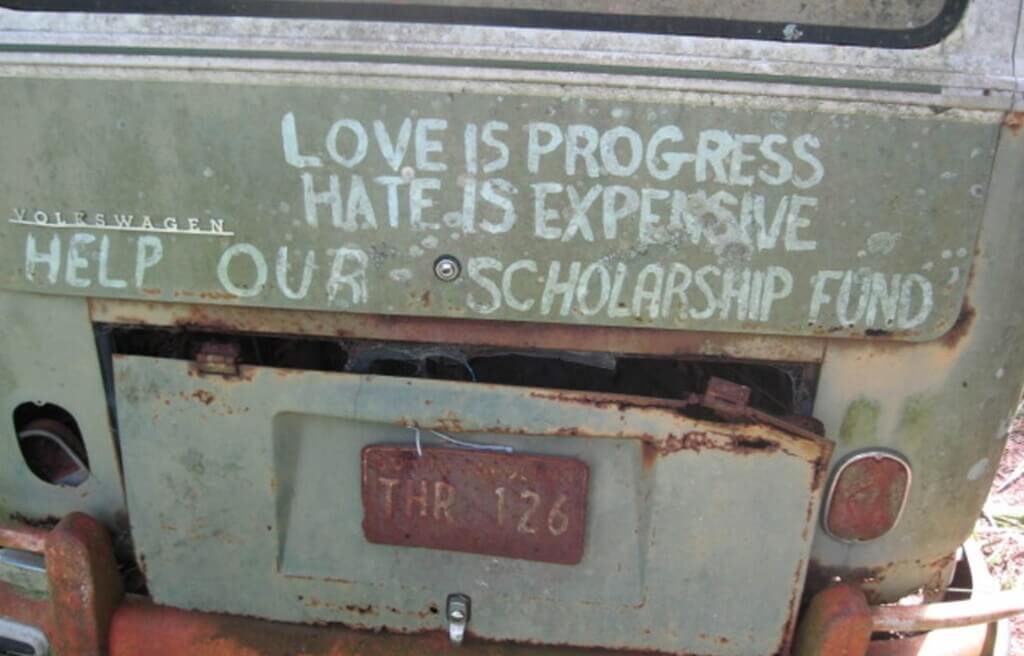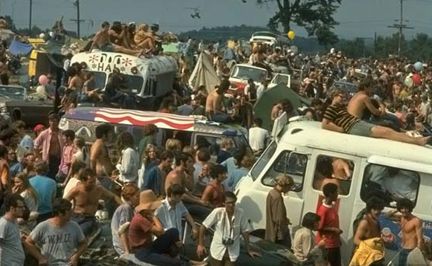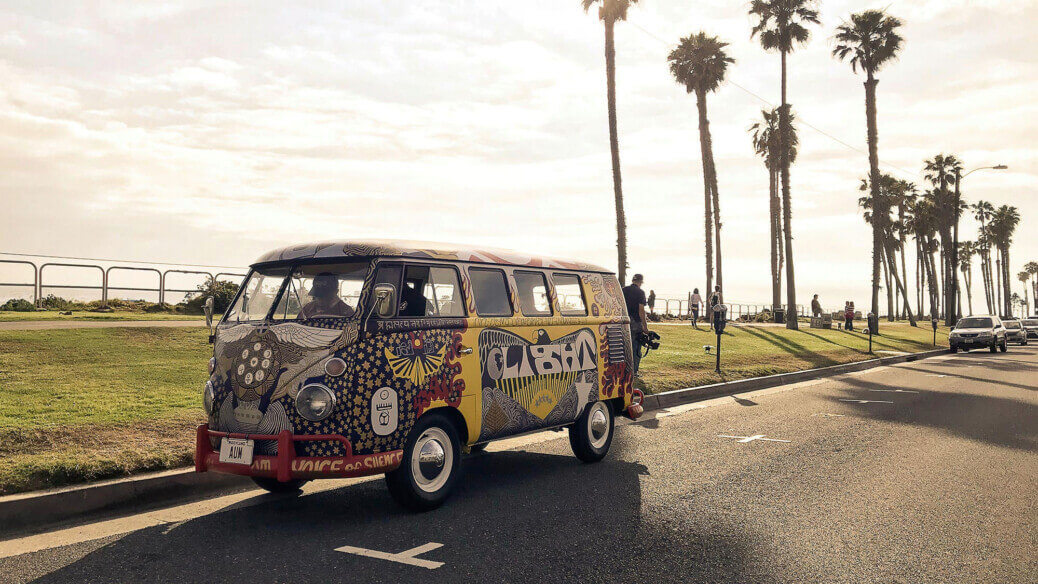How VW Buses became synonymous with counterculture and the hippie movement.
“Turn on, tune in, drop out”. These resounding words were spoken by Harvard psychologist and counterculture figurehead, Timothy Leary. This was 1967, at the Human Be-In gathering in Golden Gate Park. These words penetrated the souls of thousands of Americans who were looking for social change, freedom, and revolution. These Americans felt suffocated in the box that society had stuffed them into. It was time to grow, and take new roads that stretched beyond the white-picket-fence built by the American Dream. There was a world in the distance with no fences and no limits. A world where people were free to explore new dreams. It did however include the VW Bus.
The birth of the VW “Splittie”
Years before America began its revolution, in 1950, the world of automobiles had its own revolution. The introduction of the VW T1. Otherwise known as the ‘Splittie’, the T1 was one of the first domestic microbuses to be introduced to the market. Unlike other vehicles at that time, it was boxy and utilitarian in style with a focus on spaciousness and functionality. The flat-faced 170-cubic-foot oblong vehicle featured a rear air-cooled engine, a split angled windscreen, and nine seats, three of which were removable from the rear, allowing it to transport large groups of people at one time. Needless to say, the microbus stood out amongst its peers. Thanks to its adaptability, it offered people the freedom they had never known before.
Civil rights and revolution
By the late ’50s, before the American counterculture reached its height, the VW Bus was already being used as a means for revolution. A revolution of equal rights for all races. African-American civil rights activist Esau Jenkins used the VW T1 to transport African-Americans from the remote farmlands on Johns Island and Sea Island, where jobs and education were inaccessible, to Charleston where opportunity awaited.
However, these African-Americans were descendants of the slave trade. Although classed as free citizens, segregation laws still made it almost impossible to integrate into society. The journey into Charleston was long. The VW chugged along at a mere 60mph and the island roads were rough, but Jenkins ensured it wasn’t wasted. As he drove the bus, he and his wife Janie would teach passengers to read and write, so they could qualify for the right to vote. In the years following, Jenkins and his wife went on to do many more extraordinary things for the civil rights movement but, they will always be fondly remembered for changing the lives of African-Americans in a VW Bus, which they painted with the words “Love is Progress, Hate is Expensive.”



A great shift
The Civil Rights Movement was just one strand of an entire collective mindset shift that transpired through the 1950s. The pretty bows wrapped neatly around the idea of the American Dream were already unraveling like the ribbons of a ballerina’s slipper as she spun out of control. People were beginning to realize that the democracy, rights, liberty, opportunity, and equality, that the American Dream promised was just that — a dream.
It seemed in reality, equality between race, class, and gender was out of reach; consumerism had diluted people’s principles; and the TV screen had turned their attention away from the real world. As Jack Kerouac said, “This is the story of America. Everybody’s doing what they think they’re supposed to do.” But minds began to wonder; what would it be like to live life by your own rules and standards?
The Beat generation
Jack Kerouac answered this niggling question in 1957 when he published his career-defining book, ‘On the Road’; the story of two men leaving their lives behind to drive across America for the sake of freedom and adventure. According to Kerouac, “All he needed was a wheel in his hand and four on the road”, and along the way, he found booze, jazz, and women. Controversial? Perhaps. Romantic? Undoubtedly. As much as the unwashed hedonistic characters were defined by their loose moral values, they were defined by their live-and-let-live approach to life, which seemed to afford them a deeper connection to themselves and the world around them. And while the men babbled nonsensically yet with unfathomable clarity about life’s puzzles, what they were really talking about was courage, nonconformity, spirituality, and spontaneity.
“I was surprised, as always, by how easy the act of leaving was, and how good it felt. The world was suddenly rich with possibility”, Kerouac wrote. Thus was born one of America’s first countercultures, the Beat Generation. Led by an inspiring group of literaries in San Francisco’s university scene, they turned their back on the material world in favor of the open road, and the possibilities it held. It may have been a small scene, but the beatniks ignited a fire in people. One that would only grow bigger and brighter as the years went on. The world was ready to discover what possibilities lay on the road ahead for them too. All they needed was the right vehicle.
VW adapt to the needs of the people
Luckily, the VW Bus was easy to convert into a campervan. With space for a bed, sink, and cupboards, it gave people the freedom to live without limits on the road. Seeing its potential to provide this strange new counterculture with new ways of living, Volkswagen teamed up with Westfalia to create the first VW Westfalia campervan. It maintained the style of its original T1 model but was fitted with a stylish studio couch, folding table, seat bench, roll-front cabinet, and sideboard.



Of course, the campervan became a hit with aspiring adventurers. Before long, the VW had created almost 100 possible finishes. During its evolution from microbus to campervan, the VW T1 had also evolved to become a symbol of individuality, nonconformity, and freedom, solidifying its role in the counterculture. By the mid-’60s, thousands of people across the US, many of whom were youths and students, had followed the tire marks left on unexplored paths by the Beat Generation in VW Buses, rejecting middle-class morality and forming a new kind of counterculture. Hippies.
The hippie movement
At a time when the Vietnam War was tearing the East and West in two, these bright-eyed and long-haired idealists denounced materialism and militarism in favor of a “so what, dude?” attitude, and embraced peace, love, freedom, and each other. Together, hippies believed people could expand their minds, awaken their souls, and reconnect with the Earth. They took to the open road to gather in neighborhoods and festivals fueled by sex, drugs, and rock ‘n’ roll. By now, the VW Bus wasn’t just a bus, it was a way of life.
In 1967, the San Francisco Oracle, Haight-Ashbury’s hippie newspaper printed: “A new concept of celebrations beneath the human underground must emerge, become conscious, and be shared, so a revolution can be formed with a renaissance of compassion, awareness, and love, and the revelation of unity for all mankind.” Soon after, the legendary Human Be-In gathering was held. In Golden Gate Park over 30,000 hippies congregated to listen to speakers, including Timothy Leary. They established key ideas of the hippie movement. Hearing these radical and rebellious speeches about political decentralization, communal living, higher consciousness, and other far-out concepts, it wasn’t long before over 100,000 hippies had rolled into Haight-Ashbury on a VW Bus with tabs on their tongues to join their budding community on a psychedelic journey to nirvana.



In the summer following the Human Be-In, many more mass gatherings were held. These included the famous Fantasy Fair and Magic Mountain Music Festival, to celebrate love, peace, and rock ‘n’ roll. VW Buses, painted in psychedelic colors and peace signs, became the go-to festival accessory. Not only because they were a means of living during these events, but because they were a means of individualism and expression.
The summer of love
Bands like the Grateful Dead, who had their own painted VW Bus, had made it the ‘in’ thing to do. During the day, attendees took an astral journey on LSD, created art, practiced group meditation, and vibed to live music by the likes of The Doors and Jefferson Airplane. At night, they would gather around campfires talking of dreams and progress before sliding into the back of their bus for a few hours of sleep. Although it seems to be a hazy memory for those who were there, that summer stayed with America forever. They called it the ‘Summer of Love’.
Timothy Leary once said that ”Hippy is an establishment label for a profound, invisible, underground, evolutionary process. For every visible hippy, barefoot, beflowered, beaded, there are a thousand invisible members of the turned-on underground. Persons whose lives are tuned in to their inner vision, who are dropping out of the TV comedy of American Life.” But after the Summer of Love, those invisible members emerged from the turned-on underground, and the hippie culture exploded. No longer were there just a few hundred thousand flower-powered youths gathering in small neighborhoods and fields; there were millions of them across America and around the Western world. Their message of love and peace had spread, and so had their unmistakable image.
Woodstock festival
In 1969, Woodstock Rock Festival was held in New York, and although there was a 32-act-strong line-up of rock legends, including Jimi Hendrix and Janis Joplin, nobody quite expected the event — advertised as “An Aquarian Exposition: 3 Days of Peace & Music” — to become one the world would never stop talking about. Almost half-a-million barefoot, beflowered, and beaded hippies turned up on its fields, and parked between them were hundreds of VW Buses, each painted with a colour-happy mural. It wasn’t long before the sheer number of hippies and VW’s that were spread across the vast fields of Woodstock had caught the world’s attention. And while it was the rock music that people hear when they remember the event, it’s the bold emblems on the side of VW Buses that they see.



The magic bus
Many of the microbuses became talking points at the festival for their wacky artistry. There was one in particular that caught the media’s eye: the Light bus, or ‘the magic bus’. The mural on the magic bus, commissioned by the band ‘Light’, featured mysterious ancient and cosmic symbols, motifs, and words with psychedelic flare. The artist, Bob Heironimus, explained “the bus is really about being one people on one planet.”
While VW Buses had been associated with the hippie culture for a number of years already, the magic bus, as it rolled into Woodstock in all its weird and wonderful glory under the world’s watchful eye, seemed to beautifully finalize the marriage of the two. The countercultures that uprooted an entire generation through the ’50s and ’60s were no longer seen as a ‘rebellious phase’. They were the cause of a global awakening. To the idea that it was possible to reject society’s standards and form a world around your own ideals.
VW Bus becomes the people’s car
As Leary explained in his 1983 autobiography, ‘Flashbacks’, the phrase “Turn on, tune in, drop out.” was intended to urge people to activate their inner consciousness, tune into the world around them, and commit to mobility, choice, and change as a means of greater self-reliance. Well, they did it — and Woodstock is the proof. It happened to be the VW Bus, aptly named ‘the people’s car’ by Volkswagen, that gave them that mobility. The hippies will forever be credited with solidifying the VW Bus as a symbol of counterculture. Yet, remember: “Kerouac opened a million coffee bars and sold a million pairs of Levis to both sexes. Woodstock rises from his pages.”― William S. Burroughs.
Read The Generations of the Iconic VW Bus to see how it evolved following the hippie movement.



Love it!
Pic at top is of Light, The Woodstock Bus. It was restored by my friends and a movie was produced that I played a small part in. We took the bus to Woodstock 50 and participated in many events and had a ball. I was parked along side of it many times and even was it’s security at times. I have many stories about it. People should see the movie. It’s called LIGHT,THE WOODSTOCK BUS, and it’s on HBO and Discovery. I’m rather well known in the global VW bus community and I’m friends with a few of your members, namely Lucho and Belen, and Nacho and Claire. Both of those Bus Lifers have stayed at my house, as well as many others, including Ben and Leah and Alaska of KombiLife.
Oh yeah…and the artist, Dr Robert Hieronymous is a good friend of mine.